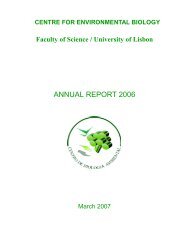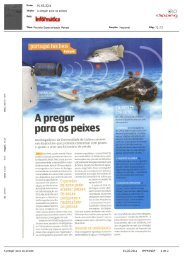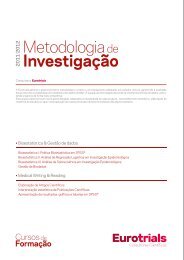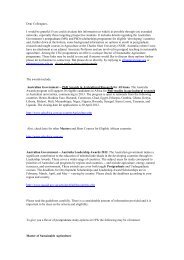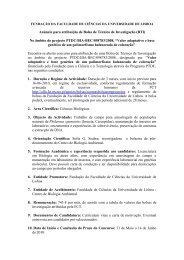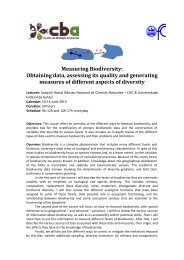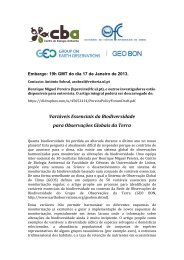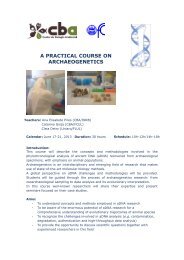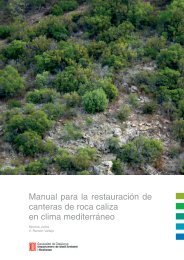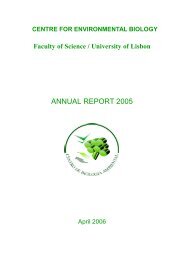European Red List of Vascular Plants - European Commission
European Red List of Vascular Plants - European Commission
European Red List of Vascular Plants - European Commission
You also want an ePaper? Increase the reach of your titles
YUMPU automatically turns print PDFs into web optimized ePapers that Google loves.
CBD targets for 2010 were not met, but these baseline<br />
data will aid efforts to meet the new targets for 2020.<br />
In order to coordinate the implementation <strong>of</strong> the<br />
GSPC at regional level, the <strong>European</strong> Strategy for Plant<br />
Conservation (ESPC) was adopted. The first <strong>European</strong><br />
Strategy was developed in 2001 by Planta Europa and<br />
the Council <strong>of</strong> Europe (2001) and was valid until 2007.<br />
At the fifth Planta Europa Conference, the Strategy was<br />
reviewed and renewed and has set targets for the period<br />
2008-2014 (Planta Europa 2008) which are aligned<br />
to the GSPC. Target 2 is again <strong>of</strong> major relevance as it<br />
requests “A preliminary assessment <strong>of</strong> the conservation<br />
status <strong>of</strong> all known plant species at national, regional and<br />
international levels”. In more detail, sub-target ESPC<br />
2.1 states that “<strong>European</strong> <strong>Red</strong> <strong>List</strong>s produced by 2014<br />
(review <strong>of</strong> progress in 2011), vascular plants completed<br />
by 2010.” This project contributed to fulfilling the target<br />
by providing an assessment <strong>of</strong> 1,826 <strong>European</strong> plant<br />
species. It will also be <strong>of</strong> vital use for the completion<br />
<strong>of</strong> Target ESPC 7.1 “60% <strong>of</strong> species <strong>of</strong> <strong>European</strong><br />
conservation priority plant* and fungal species, including<br />
crop wild relatives, conserved in situ by 2014 through<br />
the implementation <strong>of</strong> national strategies for conserving<br />
priority species (*prioritised according to their inclusion<br />
in regional and national legislation, including the EC<br />
Habitats and Species Directive, the Bern Convention and<br />
IPA programmes, and with reference to <strong>European</strong> <strong>Red</strong><br />
<strong>List</strong>s for all taxonomic groups as they are developed)”.<br />
It furthermore provides baseline information for the<br />
achievement <strong>of</strong> Targets 8 and 11 at <strong>European</strong> level.<br />
ESPC Target 9.1 stipulates by 2014: “Establishment <strong>of</strong><br />
25 <strong>European</strong> crop wild relative genetic reserves covering<br />
the major hotspots <strong>of</strong> species and genetic diversity”. This<br />
will involve:<br />
■■ Establishing a baseline <strong>of</strong> genetic diversity for priority<br />
crop complexes <strong>of</strong> <strong>European</strong> socio-economically<br />
important wild species;<br />
■■ Assessing genetic diversity change against time for<br />
these species;<br />
■■<br />
■■<br />
■■<br />
■■<br />
Creating a preliminary list <strong>of</strong> CWR in situ hotspots <strong>of</strong><br />
species and genetic diversity at national and <strong>European</strong><br />
levels;<br />
Gap analysis review <strong>of</strong> ex situ holdings <strong>of</strong> <strong>European</strong><br />
CWR species;<br />
Preparation <strong>of</strong> a priority list <strong>of</strong> <strong>European</strong> CWR;<br />
Promotion <strong>of</strong> the Crop Wild Relative Information<br />
System (CWRIS) (PGR Forum 2005, Kell et al.<br />
2008b, Moore et al. 2008).<br />
The FAO Global Plan <strong>of</strong> Action for the Conservation<br />
and Sustainable Utilization <strong>of</strong> PGRFA (FAO 1996) and<br />
International Treaty on Plant Genetic Resources for Food<br />
and Agriculture (ITPGRFA) (FAO 2001) both highlight<br />
the need to conserve CWR diversity. The ITPGRFA has<br />
as its objective the “conservation and sustainable use <strong>of</strong><br />
plant genetic resources for food and agriculture and the<br />
fair and equitable sharing <strong>of</strong> the benefits arising out <strong>of</strong><br />
their use”. Article 5 states that each contracting party<br />
shall: “Survey and inventory plant genetic resources for<br />
food and agriculture, taking into account the status and<br />
degree <strong>of</strong> variation in existing populations, including<br />
those that are <strong>of</strong> potential use and, as feasible, assess<br />
any threats to them. . . . Promote in situ conservation <strong>of</strong><br />
wild crop relatives and wild plants for food production,<br />
including in protected areas”. Focusing explicitly on<br />
CWR conservation and use, in 2005 the Global Strategy<br />
for CWR Conservation and Use was proposed at the<br />
First International Conference on Crop Wild Relative<br />
Conservation and Use in Agrigento, Sicily (Heywood<br />
et al. 2008); it established 12 objectives and associated<br />
targets that would further enhance systematic CWR<br />
conservation and use. To address these targets, along with<br />
the requirements <strong>of</strong> other relevant international, regional<br />
and national strategies and legislation, we need to be able<br />
to assess biodiversity change and threats, which for CWR<br />
requires precise knowledge <strong>of</strong> what diversity exists and to<br />
what extent it is threatened – only then can we effectively<br />
plan its conservation and sustainable exploitation.<br />
The Convention on International Trade in Endangered<br />
Species <strong>of</strong> Wild Fauna and Flora (CITES) regulates the<br />
international trade in endangered species and is legally<br />
binding to its parties. It provides a framework for<br />
countries to establish national legislation to implement<br />
the convention. The trade for all the species listed in<br />
Appendix II should be controlled in the form <strong>of</strong> export<br />
permits and re-export certificates being required. For<br />
Europe there are only species listed under Appendix II.<br />
A total, <strong>of</strong> 157 species <strong>of</strong> which 146 belong to the orchid<br />
family have been assessed, but information on a further<br />
nine Cyclamen species is missing. More information on<br />
those species can be found in chapter 3.1.<br />
The Bern Convention is a binding international agreement<br />
that aims to conserve wild flora and fauna and their<br />
natural habitats and to promote <strong>European</strong> cooperation<br />
towards that objective. There are 612 plant species<br />
listed on the Bern Convention and an assessment <strong>of</strong> all<br />
<strong>of</strong> them has been attempted in this project. Taxonomic<br />
changes in recent years made some <strong>of</strong> the species listed<br />
under Appendix I redundant (e.g. Pharbitis preauxii or<br />
Gladiolus felicis) and a taxonomic review <strong>of</strong> the Appendix<br />
is recommended. This project revealed that 327 species on<br />
47



